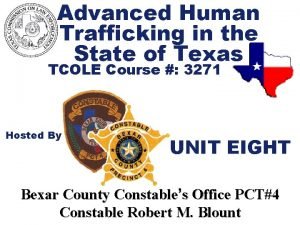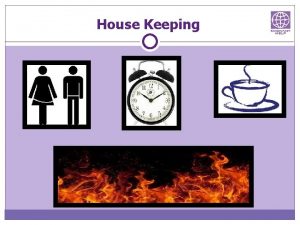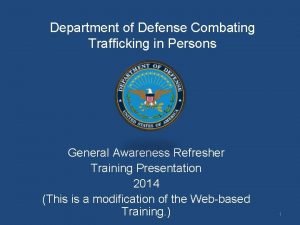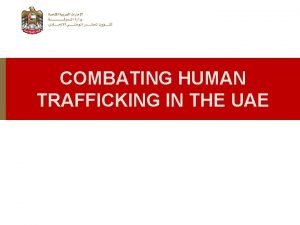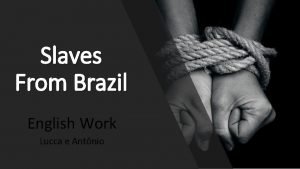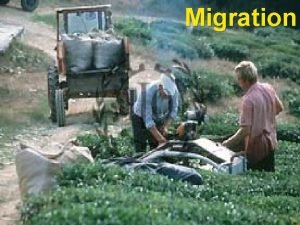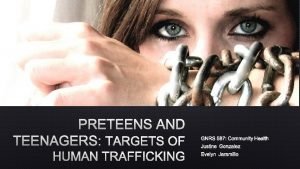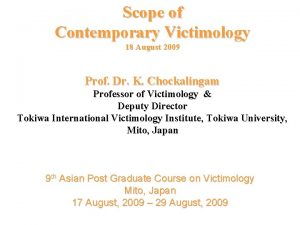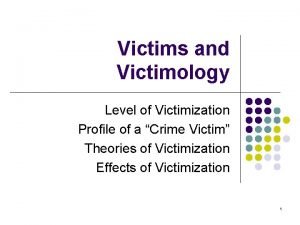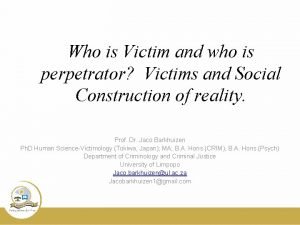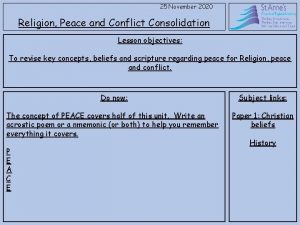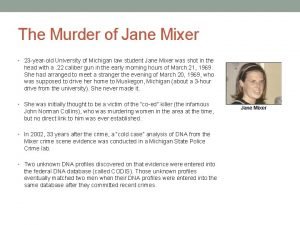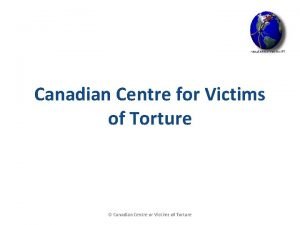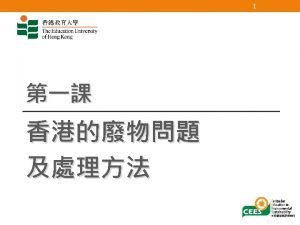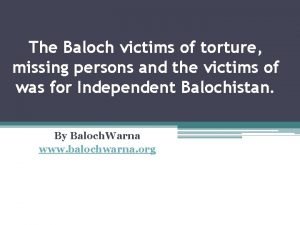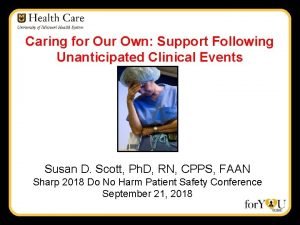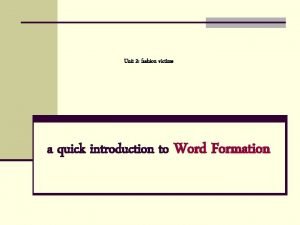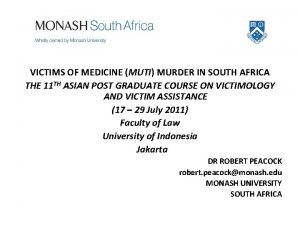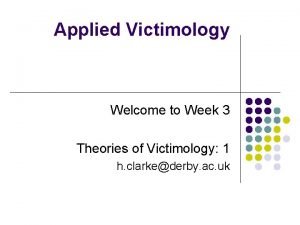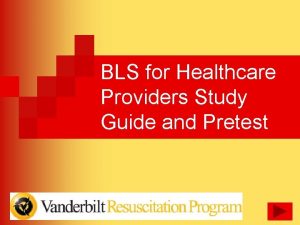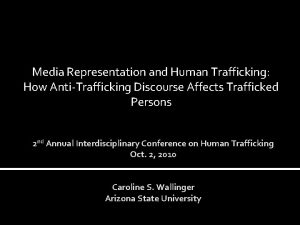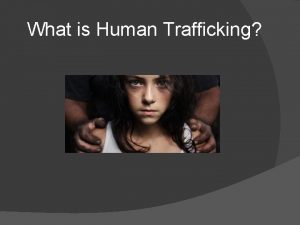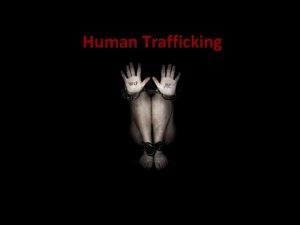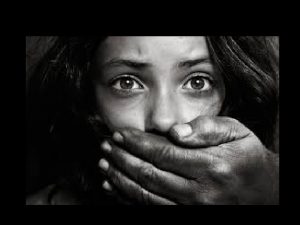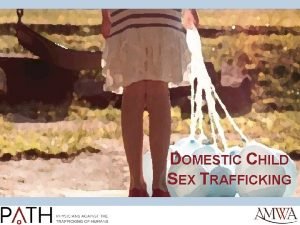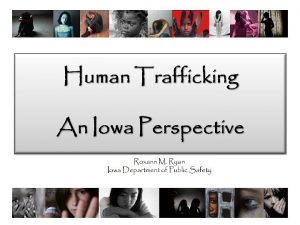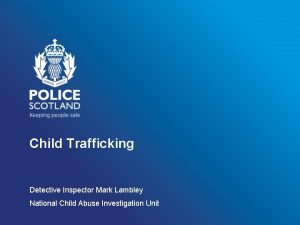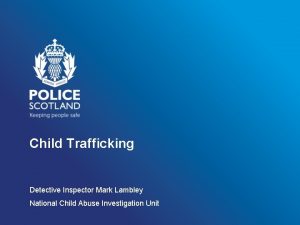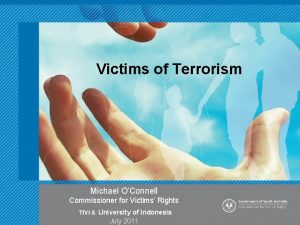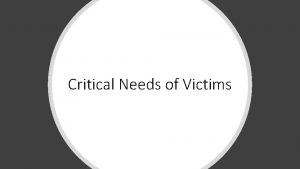Responding to Foreign Child Victims of Trafficking AntiTrafficking




































- Slides: 36

Responding to Foreign Child Victims of Trafficking Anti-Trafficking in Persons Division Office of Refugee Resettlement U. S. Department of Health and Human Services

Overview 1. Human Trafficking Overview 2. Identifying Victims of Trafficking 3. HHS/ORR Response to Human Trafficking 4. HHS/ORR Anti-Trafficking Resources

Part 1: Human Trafficking Overview

Human Trafficking is…. • the use of force, fraud or coercion for involuntary labor, debt bondage or commercial sex • modern-day slavery • a violation of human rights • global in scope • a federal crime in the United States • based on principles of supply and demand • highly profitable for traffickers who can sell the same product (human being) over and over

Who are the traffickers? • Large-scale § sophisticated national and international crime networks § highly organized from the recruitment, transportation, and exploitation stages of human trafficking § often well-connected in country of origin • Medium-scale § often specialize in a particular source and destination country § may include pimps, brothel owners, farm owners, salon owners • Small-scale § focus on recruiting a particular victim § may be neighbors, friends, “boyfriends”, family members

Promises and Methods Promises Methods • Earn money to support family back home • Receive U. S. education • Adoption • Marriage • A better life • Threats of physical harm to victim or family • Threats of deportation or arrest • Isolation • Debt • Confiscation of money, passports, visa, identification documents * Traffickers are manipulators who are skilled at gaining the trust of victims and preying on their vulnerabilities to recruit them into the trafficking situation.

The Victims • • Men, women, and children Individuals, families, or groups Diverse in race, class, religion, and culture Youth running away from unstable family environments • Homeless youth (aka “street kids”) • Youth with history of physical and/or sexual abuse

Framework for Human Trafficking Response • International – The United Nations’ Protocol to Prevent, Suppress, and Punish Trafficking in Persons (Palermo Protocol) – As of June 2013, more than 140 countries have criminalized sex and labor trafficking* • National – Trafficking Victims Protection Act (TVPA) 2000 and its subsequent reauthorizations (‘ 03, ‘ 05, ’ 08, and ‘ 13) • States – Many states have passed anti-trafficking laws or have legislation pending. * Department of State’s 2014 Trafficking in Persons Report: http: //www. state. gov/j/tip/rls/tiprpt/index. htm

Trafficking Victims Protection Act (TVPA) The Trafficking Victims Protection Act of 2000 (TVPA) defines severe forms of trafficking in persons as the recruitment, harboring, transportation, provision, or obtaining of a person for: (1) For labor or services through the use of force, fraud, or coercion for the purpose of subjection to involuntary servitude, peonage, debt bondage, or slavery; or (2) For the purpose of a commercial sex act in which the sex act is induced by force, fraud, or coercion, or in which the person induced to perform such act has not attained 18 years of age.

Key Elements of Federal Definition • Coercion means threats of serious harm to or physical restraint against any person; any scheme, plan, or pattern intended to cause a person to believe that failure to perform an act would result in serious harm to or physical restraint against any person; or the abuse or threatened abuse of the legal process. (22 U. S. C. § 7102(3)). • Involuntary Servitude “includes a condition of servitude induced by means of (A) any scheme, plan, or pattern intended to cause a person to believe that, if the person did not enter into or continue in such condition, that person or another person would suffer serious harm or physical restraint; or (B) the abuse or threatened abuse of the legal process. ” (22 U. S. C. § 7102(6)). • Peonage means a status or condition of involuntary servitude based on real or alleged indebtedness. (8 CFR 214. 11) • Debt bondage means “the status or condition of a debtor arising from a pledge by the debtor of his or her personal services or of those of a person under his or her control as a security for debt, if the value of those services as reasonably assessed is not applied toward the liquidation of the debt or the length and nature of those services are not respectively limited and defined. ” (22 U. S. C. § 7102(5)).

Key Elements of Federal Definition Action: recruitment, harboring, transportation, provision, or obtaining of a person Means: use of force, fraud, coercion Purpose: subjection to commercial sex*, involuntary servitude, peonage, debt bondage or slavery *Any child (under 18) who is induced to perform a commercial sex act is, by federal law, a victim of a severe form of trafficking in persons. Means need not apply.

Trafficking vs. Smuggling Trafficking • • Crime against a person Victims either do not consent to their situations, or if they initially consent, that consent is rendered meaningless by the actions of the traffickers. Exploitation of victims to generate illicit gains for the traffickers. Trafficking need not entail the physical movement of a person (but must entail the exploitation of the person for labor or commercial sex) Smuggling • • Crime against a country The transaction is mutual and usually ends upon arrival at desired destination. Business arrangement between smuggler and person wanting to facilitate the illicit crossing of a nation’s border. Smuggling is always transnational.

Part 2: Identifying Victims of Trafficking

Trafficking victims have been identified in the following sectors… Sex Trafficking • Street prostitution • Exotic dancing bars • Latino bars • Asian massage parlors • Residential brothels • Escort services Labor Trafficking • Domestic servitude • Agricultural labor • Sweatshops/factories • Salons (nails, hair braiding) • Janitorial work • Housekeeping • Peddling

Challenges to identification may include…. • Hidden nature of the crime • Victims often do not self-identify • Traffickers coach victims through threats and sometimes violence • Victims are fearful of harm to themselves and their families • Shame • Mistrust of authorities • Feel they are honor-bound to pay debts • Trauma bond with traffickers • Lack of understanding by community of human trafficking

Potential Indicators of Trafficking • • • • Minor (under 18) involved in commercial sex Forced to live at workplace or with employer Employer keeping identification documents Works long hours, in exploitive labor, under bad conditions Unpaid, under paid, or giving over all earnings to someone else Increasing or unending debt Coercion Threats Violence Unable to choose residence or job Recruited with false promises Agreement changes upon arrival Fear or false hope

Complex Case Trends • Interrupted, clandestine journeys • Potential Trafficking in other Criminal Activities – Drug trafficking – Hostage taking

Best Practices for Screening Children • Provide a safe and confidential environment • Clarify your role • Allow the child to make choices – where they would like to sit, when they would like to take a break or stop the interview • Use child-friendly language • Avoid leading questions and ask open-ended questions around the edges of the child’s experience • Use a qualified interpreter, if needed • Limit interviews by utilizing Child Advocacy Center model when possible • Give consideration to the role that trauma may play in the child’s response to the interview process • Assess child’s age and brain development prior to conducting interview • Take time to build rapport

Sample Screening Questions • • • What type of work do you do? If commercial sex – is anything of value exchanged? * Describe your working conditions. – – – • • How many hours do you work? How often do you get paid and how much? Do you owe money to anyone? If so, how much? How do you get to and from work? Do you have to ask permission to eat, sleep or go to the bathroom? Describe your living conditions. Have you been physically harmed in any way? Are you afraid of someone harming you or your family? Do you have your identification papers? *Minors induced to perform a commercial sex act are victims of human trafficking, regardless of force, fraud, or coercion.

Protocols for a Child Protection Response • • • Safety issues Guardianship issues Engaging CPS Immediate and long-term placement options Interviewing children ØChild trauma and developmental issues ØChallenges and resources

Part 3: HHS/ORR Response to Human Trafficking

U. S. DEPARTMENT OF HEALTH AND HUMAN SERVICES (DHHS) ADMINISTRATION FOR CHILDREN AND FAMILIES (ACF) OFFICE OF REFUGEE RESETTLEMENT (ORR) ATIP DCS UAC URM * There are other ORR divisions (DRA, DRS, and DRH) that assist refugee populations, but DCS and ATIP specifically address the needs of child victims of trafficking.

DIVISION OF ANTI-TRAFFICKING IN PERSONS (ATIP) – Created to implement the Trafficking Victims Protection Act of 2000 (and subsequent reauthorizations) DIVISION OF CHILDREN’S SERVICES (FORMALLY DUCS) – Created by the Homeland Security Act of 2002; transferred care/placement of Unaccompanied Alien Children (UAC) from Immigration and Naturalization Services (INS) to ORR in 2003 – Provides temporary shelter to UAC, including those who are potential or eligible victims of trafficking. UNACCOMPANIED REFUGEE MINORS (URM) PROGRAM – Created in 1979 to serve unaccompanied children coming to the U. S. from refugee camps. – A long-term placement option for eligible, UAC victims of trafficking.

Division of Anti-Trafficking in Persons (ATIP) • Rescue & Restore Victims of Human Trafficking public awareness campaign • Rescue & Restore Regional Program • Comprehensive case management services foreign victims of trafficking • National Human Trafficking Resource Center (NHTRC): 1 -888 -373 -7888 • Certification and Eligibility Letters

Requesting Assistance for a Potential Foreign Child Victim of Trafficking • Request for Assistance for Child Victims of Human Trafficking form www. acf. hhs. gov/trafficking/ • Provides information for ORR to determine if a child may be eligible for assistance • Submit forms to: childtrafficking@acf. hhs. gov or by fax to: 202 -401 -5487

When Preparing a Case for Referral… • Ensure the case summary reflects the elements of the federal definition of a severe form of trafficking. • State facts and child’s statements only, no assumptions please. • Be specific, but only information germane to the trafficking situation is necessary. • If interviewing the child, remember to take a childfocused, victim-centered approach. • Use open-ended questions that will not be leading, and will allow for detailed responses.

Child Trafficking Law Enforcement Reporting Responsibility Section 107(b)(1)(G) of the TVPA: “Not later than 24 hours after a Federal, State, or local official discovers that a person who is under 18 years of age may be a victim of a severe form of trafficking in persons, the official shall notify [HHS] to facilitate the provision of interim assistance. . ” Contact us at: childtrafficking@acf. hhs. gov or 202 -205 -4582

Eligibility Letter • Issued by ORR to a foreign child who is determined by ORR to be a victim of a severe form of human trafficking • Cooperation with law enforcement is not a requirement foreign children to be issued an Eligibility Letter • Receipt of Continued Presence, a bona-fide T visa determination or T nonimmigrant status is not required for a foreign child to be issued an Eligibility Letter • Eligibility Letters do not expire

Interim Assistance • ORR issues an Interim Assistance Letter to a foreign child who may have been subjected to trafficking • It provides a 90 -day period of eligibility for benefits while the case is under ORR/ATIP review and additional information is collected. • After issuing interim assistance, HHS/ORR is required to consult with the U. S. Departments of Justice and Homeland Security and nongovernmental organizations with expertise on victims of trafficking before determining the child's eligibility as a victim of trafficking. • Cooperation with law enforcement is not a requirement for a foreign child to be issued an Interim Assistance Letter • ORR State Letter regarding Interim Assistance: http: //www. acf. hhs. gov/programs/orr/policy/sl 10 -05. htm

Benefit Options for Minors with Eligibility Letters • URM Program • Access to benefits and services to the same extent as a refugee, to include, but not limited to: – Medicaid or Children’s Health Insurance Program (CHIP) – Temporary Assistance for Needy Families (TANF) – Free Application for Federal Student Aid (FAFSA) – Food Stamps (SNAP)

Program Division of Children’s Services-Unaccompanied Alien Children (UAC) Unaccompanied Refugee Minors (URM) Placement • 24 -hour care for all UAC • 24 -hour care for certain categories of unaccompanied, non-U. S. citizen minors, including those with ORR Eligibility Letters • Placements made 24/7 by Federal agency calling UAC hotline number at 202 -401 -5709 • Federal agency must transfer UAC in custody to ORR within 72 hours • Placements made only M-F during normal business hours by NGOs. Contact HHS ORR for assistance Locations 13 states, 80 sites & foster care HHS/ORR funds grantees directly and monitors programs, all of which are State-licensed 15 states, 20 programs (and 3 sub-offices) HHS/ORR funds states that oversee/administer URM programs and contract with State-licensed providers Average Length of Stay Temporary Care 30 -45 days • Released to sponsor (approx. 85%) • Repatriated (approx. 1. 4%) • Age out (approx. 1. 4%) Long Term Care 3 -4 years (usually enter as teens) Depending on State, youth could be in program up to age 23 receiving independent living services and/or educational/training vouchers. Custody Federal Government State, County or Private Agency (dependency/custody MUST be established by court before 18 th birthday) • Admission to URM Program may take months

Reporting Responsibilities • Federal, State, and Local officials: Do you believe an alien minor may be a victim of human trafficking? If yes, you are required by federal law to notify HHS to facilitate assistance. (22 USC § 7105(b)(1)(G)) Call an ORR/ATIP Child Protection Specialist at 202 -205 -4582. • Do you believe a minor may have been abused, abandoned, or neglected by a caretaker in the United States? If yes, contact your local child welfare agency to make a report. Note: Mandated reporter laws and child protection policies vary greatly depending on your jurisdiction. If you have any questions, reach out to your local child welfare agency.

Part 4: HHS/ORR Anti-Trafficking Resources

Rescue & Restore Resource Materials

Rescue & Restore Campaign website www. rescueandrestore. org

Anti-Trafficking in Persons Division Child Protection Specialist childtrafficking@acf. hhs. gov 202 -205 -4582 http: //www. acf. hhs. gov/trafficking/
 Here you are too foreign for home
Here you are too foreign for home Advanced human trafficking 3271
Advanced human trafficking 3271 What is human trafficking
What is human trafficking Aims and objectives of human trafficking
Aims and objectives of human trafficking What is trafficking in persons
What is trafficking in persons Combating human trafficking in the uae
Combating human trafficking in the uae Ctip clause that must be included in every contract
Ctip clause that must be included in every contract Human trafficking
Human trafficking Advanced human trafficking #3271 test answers
Advanced human trafficking #3271 test answers 3271 advanced human trafficking
3271 advanced human trafficking Human trafficking map
Human trafficking map Human trafficking definition
Human trafficking definition Infested
Infested Ideas have consequences bad ideas have victims
Ideas have consequences bad ideas have victims Menachem amir contribution to victimology brainly
Menachem amir contribution to victimology brainly Psychological types of victims
Psychological types of victims What is victimology
What is victimology Religious beliefs about helping victims of war
Religious beliefs about helping victims of war Mary frances tinning
Mary frances tinning Joseph g christopher
Joseph g christopher Mary fleszar
Mary fleszar Hyatt regency walkway collapse engineering ethics
Hyatt regency walkway collapse engineering ethics Explain two contrasting understandings of salah
Explain two contrasting understandings of salah Dorothea puente childhood
Dorothea puente childhood Victims
Victims Canadian centre for victims of torture
Canadian centre for victims of torture Canadian centre for victims of torture
Canadian centre for victims of torture Thourghout
Thourghout 3 tiers of support for second victim
3 tiers of support for second victim Pack strap carry
Pack strap carry Atomic shadow
Atomic shadow Richard trenton chase childhood
Richard trenton chase childhood Fashion word formation
Fashion word formation Characteristics of the victims of muti murders
Characteristics of the victims of muti murders Theories of victimology
Theories of victimology After positioning yourself directly above the victims head
After positioning yourself directly above the victims head West memphis 3 crime scene photos
West memphis 3 crime scene photos

